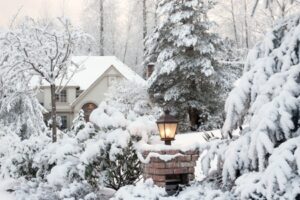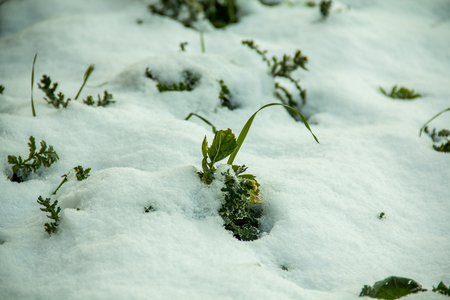
The winter means we can take a break from our normal lawn care routine. We already fertilized in the fall and there’s no need to mow, so that means we can sit back and relax until spring!
However, while you’re taking a leave of absence from your lawn care, your lawn is battling cold temperatures and snow.
Here are just a few ways that snow affects your lawn during the winter season!
Freezing temperatures cause frozen grass blades
When the temperatures take a dive, your grass takes the plunge as well, growing weak and sometimes dehydrated.
With the blades now frozen, deep into your grass, it easier for breakage to occur. Any pressure, like walking across your yard will result in fracturing your grass. Ultimately, the blades will recover, but it may take until next spring.
Beware of snow mold growth
The most common drawback of snow on a lawn is snow mold.
This mold typically appears as white, pink or gray patches of grass far after the snow has melted. It’s caused by the residual moisture left by melting snow and ice in areas of your lawn where these elements accumulated.
The good news is that most cases are fairly mild and can easily be repaired by lightly raking the affected area to loosen the grass and promote new growth.
Rock salt can burn grass
In cold climates, many homeowners use rock salt to keep their driveways and sidewalks free of ice during the winter months. While all that salt will make paved surfaces far safer to walk on, it can also burn your grass if you’re not careful.
Take care to avoid the edges of your lawn when you spread salt on adjacent surfaces. This way you won’t be left with a white border of dead grass around your lawn when the spring rolls around.
Now there is some good that comes from a coating of snow across your lawn.
Nitrogen levels

When snow falls, it captures ambient nitrogen in the air and preserves it until it melts. Once it does begin to melt, that nitrogen leeches down into the soil in your yard. This means that seasonal snowmelt can actually provide your lawn with an early dose of fertilizer to help it rally for the spring.
Snow helps to hold in moisture
Snow prevents transpiration, which could harm our lawn during the winter. The cold and dry winds can extract the moisture from your grass, which of course would occur mostly in the cold winter months.
However, with a layer of snow over the top, your grass blades are protected, successfully holding onto their moisture.
The winter may definitely put your lawn through the ringer, but we know that you’ll be fully prepared to give it the care it needs come spring!
Check out our blog for more landscaping and gardening tips and tricks and call on Suburban Lawn Sprinkler Co. when you need a helping hand. We install efficient sprinkler systems, design expert landscape lighting layouts and provide exceptional holiday and event lighting services. Give us a call at 508-872-2727 to learn more!







Our sprinklers are on now because of the warm weather but we are getting a lot of snow should the sprinklers be turned off?
How shall I prepare my lawn for snow? Should I add nitrogen?